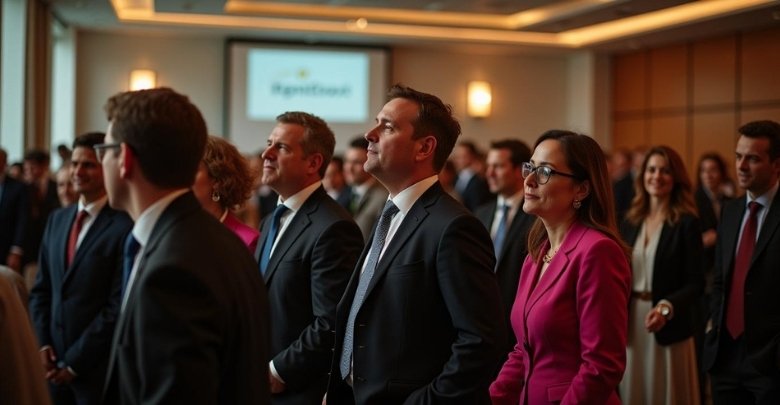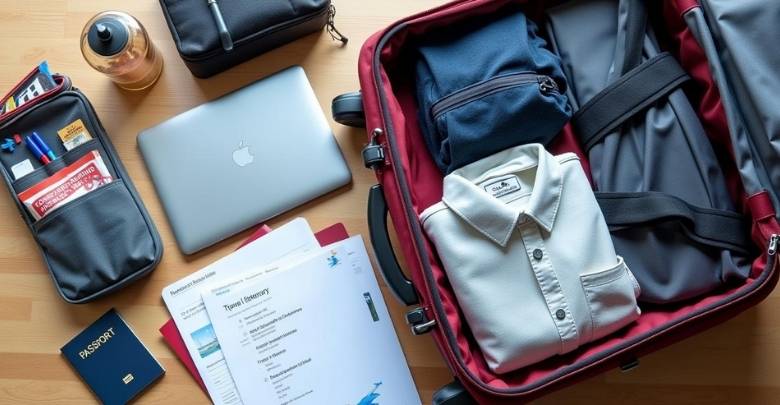When attending an academic conference, women want to look polished and professional while feeling comfortable throughout the event. The right attire can make a big difference in how you’re perceived and how confident you feel. So, what should a woman wear to an academic conference?
A woman should wear business casual attire to an academic conference, such as a blouse, knee-length skirt or dress pants, a blazer, and closed-toe shoes. To ensure a polished look for long periods of sitting and standing, the focus should be on professionalism, comfort, and modest cuts.
Interested in learning more about this topic? Check out our practical advice on how to dress for academic conferences in a trendy and functional way.
What Should a Woman Wear to an Academic Conference for a Professional Look?
Academic conferences can be valuable experiences, especially if they’re international. For a positive first impression, make sure you dress appropriately. Here’s what to wear to ensure you look professional and feel comfortable.

Choosing the Right Top
A smart blouse sets the tone for a polished look. Opt for solid colors or subtle patterns that project professionalism. It should fit well without being too tight or overly loose. Fabrics like cotton, silk, or blended materials breathe well, keeping you comfortable throughout the day.
Selecting Suitable Bottoms
Knee-length skirts and dress pants are excellent choices for academic conferences. Ensure they complement the color and style of your top for a cohesive outfit. A well-tailored fit strengthens your professional appearance and gives you confidence. Choose wrinkle-resistant fabrics like wool or polyester to keep looking sharp throughout the event.
Incorporating a Blazer
A blazer polishes any business casual outfit and instantly transforms your look. Neutral colors like black, navy, or gray are versatile and work with most combinations. The blazer should fit comfortably and button without straining, allowing you to move freely. This piece can be removed if the conference room is warm or during casual networking moments.
Footwear for Comfort and Style
Closed-toe flats or low heels are the best footwear options for an academic conference. They provide the perfect balance between comfort and professionalism, helping you stay comfortable during long hours. Avoid high heels to maintain comfort during long standing periods. Make sure the shoes are in good condition and match the overall tone of your outfit.
Accessorizing Appropriately
Accessories should be understated yet elegant to maintain a professional image. A simple watch or a pair of small earrings can add a touch of personality without distraction. Avoid large, flashy jewelry that could detract from your overall appearance. A professional tote or handbag for your materials keeps you organized and adds a polished final touch.
You can use this guide to prepare your wardrobe for upcoming international conferences, ensuring you feel confident and ready to engage. Remember to consider the cultural norms and climate of the host country when selecting your outfits.
Why Comfort Matters in Academic Conference Attire?
A professional appearance that is comfortable throughout the day is required for academic conferences. Long hours of sitting, standing, and networking demand practical clothing choices. Here’s why comfort in conference attire is crucial and how to achieve it effectively.
Ensures Confidence Throughout the Day
Wearing comfortable clothing helps maintain confidence during long conference hours. Tight or restrictive outfits can cause unnecessary discomfort and distraction. Properly fitted attire allows you to focus on presentations and networking. Confidence stems from looking good and feeling great simultaneously.
Supports Physical Endurance
Comfortable attire accommodates long periods of sitting and standing without strain. Stiff materials or ill-fitting clothing can lead to fatigue. Breathable fabrics like cotton or blends help regulate body temperature. Choosing flexible outfits ensures you move freely during sessions and breaks.
Boosts Professional Interactions
Appropriate, comfortable clothing creates a positive impression during conversations. Discomfort can lead to fidgeting, which may distract others during interactions. Properly chosen attire makes you approachable and confident. Networking success often begins with how at ease you feel in your outfit.
Prevents Unnecessary Distractions
Uncomfortable clothing can divert your focus from key conference activities. Constant adjustments to tight or loose clothing waste valuable time. Choosing attire that fits well eliminates such worries. Stay fully engaged in sessions without worrying about your appearance.
Enhances Productivity
Clothing that feels good improves your ability to concentrate during presentations. Discomfort may lead to restlessness, affecting your learning experience. Comfortable shoes, in particular, make walking and standing more manageable. Staying productive starts with attire that supports your physical needs.
Balances Style and Practicality
Comfortable attire doesn’t mean compromising on style or professionalism. Choose classic business casual pieces that fit well and flatter. Modest cuts and clean lines ensure a polished appearance without discomfort. Balance practicality with aesthetics for a successful conference wardrobe.
Academic Conference Attire Types That Aren’t Comfortable
Your comfort and focus can be hindered if you wear the wrong outfit to an academic conference. Some clothing types may look professional but lack practicality for long days. Listed below are attire options to avoid and why they are not comfortable.
| Attire Type | Reason for Discomfort | Better Alternative |
| Tight-fitting Blouses | Restrict movement and can cause discomfort during extended periods. | Choose well-fitted, breathable blouses. |
| High Heels | Cause foot pain and limit mobility during walking or standing. | Opt for low heels or comfortable flats. |
| Heavy Fabrics | Lead to overheating and discomfort in warm conference venues. | Select lightweight, breathable fabrics like cotton or blends. |
| Overly Formal Suits | Feel stiff and restrictive for long hours of sitting or standing. | Try tailored business casual outfits with a blazer. |
| Skirts Above the Knee | May restrict movement and feel inappropriate for professional settings. | Knee-length skirts for balance between style and function. |
| Loose or Baggy Clothes | Appear unkempt and may snag or feel awkward in crowded spaces. | Wear properly tailored and polished attire. |
Typical Mistakes to Avoid While Balancing Style and Comfort at Academic Events
Balancing style and comfort at academic events can be tricky. Missteps in attire choices can affect your confidence and focus. Avoid these common mistakes to ensure a polished and professional look.
- Wearing Ill-Fitted Clothes: Clothing that’s too tight or loose can be distracting and uncomfortable. Properly tailored pieces provide both style and comfort.
- Choosing High Heels for Long Days: High heels may look elegant but cause foot pain after hours of standing. Opt for low heels or supportive flats.
- Ignoring Breathable Fabrics: Fabrics like polyester can trap heat and make you uncomfortable. Choose breathable materials like cotton or linen for longer events.
- Overdoing Accessories: Large, flashy accessories can overpower your look and feel heavy. Stick to minimal, elegant pieces to maintain a professional vibe.
- Opting for Inappropriate Lengths: Skirts or dresses that are too short may hinder movement and appear unprofessional. Knee-length options offer style and practicality.
- Skipping a Blazer: Skipping a blazer can make your outfit look incomplete. A well-fitted blazer adds structure and upgrades your look.
- Not Considering Venue Conditions: Ignoring room temperature can lead to discomfort. Layering ensures you stay comfortable in varying conditions throughout the event.
- Neglecting Comfortable Footwear: Uncomfortable shoes can ruin your day, especially if walking is required. Select shoes that align with both comfort and aesthetics.
- Failing to Plan Ahead: Waiting until the last minute to decide can lead to outfit mismatches. Plan your attire after you identify a high-quality conference that suits you.
- Overlooking Practical Accessories: Forgetting essentials like a professional tote can disrupt your organization. Practical accessories help you stay efficient and polished.
Best Ways to Ensure Your Academic Conference Journey Is Trouble-Free
Academic conferences can be both exciting and overwhelming. With proper planning, you can focus on learning and networking without feeling stressed. Follow these tips for a smooth and productive experience.
Plan Your Travel and Accommodation Early
Booking your tickets and hotel in advance saves time and money. Look for accommodations close to the venue for convenience. Double-check your travel itinerary to avoid last-minute surprises. Keep your confirmation details handy for quick reference during your journey.
Prepare a Well-Organized Schedule
Review the conference agenda to prioritize sessions of interest. Allocate time for networking and breaks to avoid exhaustion. Mark key speakers and events you don’t want to miss. Use a planner or app to keep your schedule organized.
Pack Smart for the Event
You should pack essential items for a short academic conference, including business attire, comfortable shoes, and necessary gadgets. Ensure your laptop, chargers, and stationery are ready. Keep your documents and ID accessible in a dedicated folder. Leave unnecessary items behind to travel light and stress-free.
Familiarize Yourself with the Venue
Research the conference location to understand the layout and nearby facilities. Check for parking or public transport options if needed. Knowing the venue helps you save time navigating between sessions. Arrive early to settle in and locate your preferred seating area.
Stay Connected with Colleagues and Organizers
Share your contact details with peers and organizers for seamless communication. Join conference-related groups or apps for updates and networking. Engage with attendees to build valuable professional connections. Staying connected ensures you make the most of the experience.
Maintain Your Health and Well-Being
Carry snacks and water to stay hydrated and energized throughout the day. Take short breaks to relax and recharge between sessions. Wear comfortable attire that supports long hours of sitting or standing. Adequate rest and self-care ensure you’re at your best during the event.
Common Questions and Answers
Dressing for an academic conference can feel overwhelming, especially for women who want to balance professionalism and comfort. To address common concerns and uncertainties, here’s a list of frequently asked questions to help you confidently choose the perfect attire.
What Colors Are Best for Academic Conference Outfits?
Neutral tones like black, navy, gray, or beige work well for academic conferences. These colors convey professionalism and are easy to match. You can incorporate subtle pops of color through accessories or blouses for a touch of personality without overwhelming the look.
Are Sleeveless Tops Appropriate for Conferences?
Sleeveless tops can be acceptable if styled appropriately with a blazer or cardigan. Ensure they are modest, with a high neckline and professional fabric. Avoid spaghetti straps or overly casual tank tops, as they may appear too informal for the event.
What Type of Handbag Is Suitable for a Conference?
A structured tote or satchel is ideal for conferences, as it combines functionality and professionalism. Ensure it’s large enough to hold essentials like notebooks, chargers, and personal items. Avoid overly casual or flashy bags to maintain a polished appearance.
Are Bright Patterns Acceptable in Conference Outfits?
Bright patterns can be acceptable if used sparingly and balanced with neutral pieces. Stick to subtle prints or one statement piece to avoid looking too loud. Excessively bold patterns may detract from a professional image, so use them cautiously.
Can Women Wear Cardigans Instead of Blazers?
Cardigans can be a great alternative to blazers, provided they look structured and professional. Choose neutral or solid-colored cardigans that fit well. Avoid overly loose or casual styles to maintain a polished and business-like appearance.
Should I Bring a Change of Clothes for Networking Dinners?
Bringing a change of clothes for networking dinners can be helpful, especially for more formal settings. Opt for a professional yet slightly dressier outfit. Keep the transition simple with a versatile dress or outfit that easily adapts to an evening event.
Bottom Line
Academic conferences require a balance between professionalism, comfort, and practicality when it comes to dressing. Having a polished appearance boosts confidence as well as creates a positive impression during interactions. When considering what should a woman wear to an academic conference? focus on business casual attire like blouses, knee-length skirts, dress pants, and comfortable closed-toe shoes. These choices ensure ease during long hours of sitting, standing, and networking.
In addition to being extremely comfortable, well-fitted clothing and subtle accessories also enhance both style and functionality. By avoiding common mistakes like overly formal or restrictive outfits, women can balance style with comfort effectively. Having a well-planned wardrobe will allow attendees to be fully engaged in the event, establish valuable connections, and leave a lasting impression.







